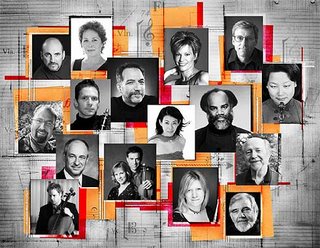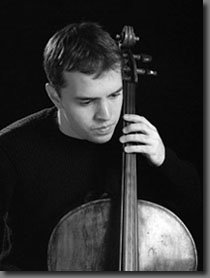A Sunday with the Contemporary Music Forum and Young Concerts Artists
Young Concert Artists
Hearing works by Benjamin C.S. Boyle more and more often and in more and more prestigious venues is very gratifying. (Although my musical tastes tend to a more modern idiom than Boyle usually delivers, the quality of the music itself and its play with traditions and contemporary influences has fascinated me ever since first hearing his Kreutzer Concert-Variations.) The Young Concert Artists’ recital at the Kennedy Center’s Terrace Theater, last Sunday, offered such an opportunity. Now in his second year as composer-in-residence for YCA, he was commissioned to write a piece for the young harp virtuoso Emmanuel Ceysson. The resulting Suite Sylvanesque adds only another work to a string of successes. Being just about the least notably modern work I have heard of Mr. Boyle’s, most of the audience would probably not have thought the Suite any younger a work than the Fauré, Ravel, Renié, or Grandjany works that were also offered by Mr. Ceysson.
Were Boyle’s Suite lulls the ears with beauty rather than piquing it with little reminders of ‘music in 2006’ – and assuming that one might consider that a shortcoming, not an asset, in the first place – it won its laurels on brevity, that most underrated but essential skill that makes a good composer. (The grand-master of brevity, Anton Webern, was present in spirit, if not at all in sound.) Five sparkling, generally gentle movements – each supplied with a short epigraph – make for music that sounded genuinely tailored to the harp and the romantic stereotype we often associate with it.
Mr. Ceysson, in his very early twenties, played this with the same flair and impeccable, impressive skill as he did the other works. During a transcription of Bach’s French Suite No. 3 BWV 814 his red-cheeked, angelic face with puckered lips ecstasy under a well cared for mop of soft, long, dark hair made that ‘romantic abandon’ impression that is especially annoying with pianists but more forgivable with the engaged, flair-burdened harpist.
Fauré’s Une chatelaine en sa tour, op.110, consisted of muted, melting tones, Marius Constant’s Harpalycé showed that the harp need not necessarily be angelic but that it can be a raw instrument, too. In Marcel Grandjany’s Rhapsody for harp and string quartet the magnificent Jupiter String Quartet was sadly underutilized. Henriette Renié’s Ballade fantastique on Edgar Allen Poe’s “The Tell-Tale Heart” would have been just as extraordinarily effective music if one were blissfully unaware of the story (and that beating heart) that motivated it.
Ravel’s Intro & Allegro for Harp, accompanied by String Quartet and Clarinet makes no pretense of being a septet – the partners here hare decidedly not equal, especially with the String Quartet relegated to provide the orchestral carpet for the harps solo performance.
Amid all this, the prodigious technique and talent of Mr. Ceysson was in full display. The only criticism: He should not have talked at all… not introduced a work nor read the poetry that goes along with the Suite Sylvanesque. His thick accent rendered it completely incomprehensible, awkward… even embarrassing. The effect was one that detracted, rather than added to the music.
contemporary music forum
If the YCA concert was six seventh 20th century music, it still could not have been more different from the second cmf concert of the season at the Corcoran Gallery of Art where five sixths were also from the 20th century (with one piece from the 21st) but the soundscape worlds apart. The recently deceased James Tenney – unknown to most audiences but a favorite composer of Ligety’s and well respected by his colleagues Feldman, Cage, and Reich – came first with the Chromatic Cannon in the version for piano and tape (a pre-recorded piano track that would otherwise fall to a second player). An intriguing work that sounds like minimalism but hardly betrays its (loosely applied) 12-tone technique, builds slow but irresistible climaxes, and plays with different pulses running through the two piano parts. Jenny Lin, who played ‘with herself’, made the Chromatic Cannon appear a downright elegant piece.
Daniel Ginsberg, Contemporary Music Forum (Washington Post, November 13) |
Lawrence Moss’ “Korea for Kwartludium” (1999) for violin (Lina Bahn), clarinet (Kathleen Mulcahy), percussion (Svet Stoyanov), and piano (Ms. Lin) is based on the interesting concept of recreating or emulate an electronically assembled earlier composition of his (Korea). The same principle as on the “Accoustica plays Aphex Twin” CD, but with Korean folk elements, instead of Richard D. James’ brand of electronica. Interesting, but lacking: There was no sense of improvisation or spontaneity in this performance, only theatrical, self-important sound-reproduction which had its low points in the instrumentalists half-yelled ‘uuuuuhs’ and ‘ooohmms’.
Transfigured Wind IV for flute and audio fared better but could have been half as short. Carole Bean played this overlong 1985 work by Roger Reynolds (a Pulitzer Prize winner in 1988) which began with subtle piccolo interjections from the audio source which sounded like someone practicing in the room next door. The taped part became more complex, before lower, earthy flute chatter entered the ears. “Climax” is too much a word for it – but halfway through Transfigured Wind IV there came a particularly busy and pleasing passage before everything mellowed out into a bland, occasionally interrupted, modernist mélange. It did, fortunately, avoid most of the histrionics that other contemporary works for flute are prone to.
The Khan Variations by Alejandro Viñao for solo marimba were an impressive showcase for Mr. Stoyanov who proved great athleticism and musicianship alike in this Nusrat Fateh Ali Kahn based musical exploration. Migrations from 1997 by Alexandra Gardner, a D.C. native, closed the concert with a wild ride for percussion/marimba and piano strings (hit directly) around flute, clarinet, cello, and the piano, more conventionally steered. There was plenty thunder but melancholy underneath; the aggressive and abrasive outbursts of the music didn’t scare even Ms. Bahn’s tiny little daughter who, after escaping her minder, progressively climbed towards her mother; reaching her just in time to take bows with the musicians. It was the most human touch of the evening.
























































